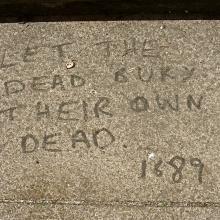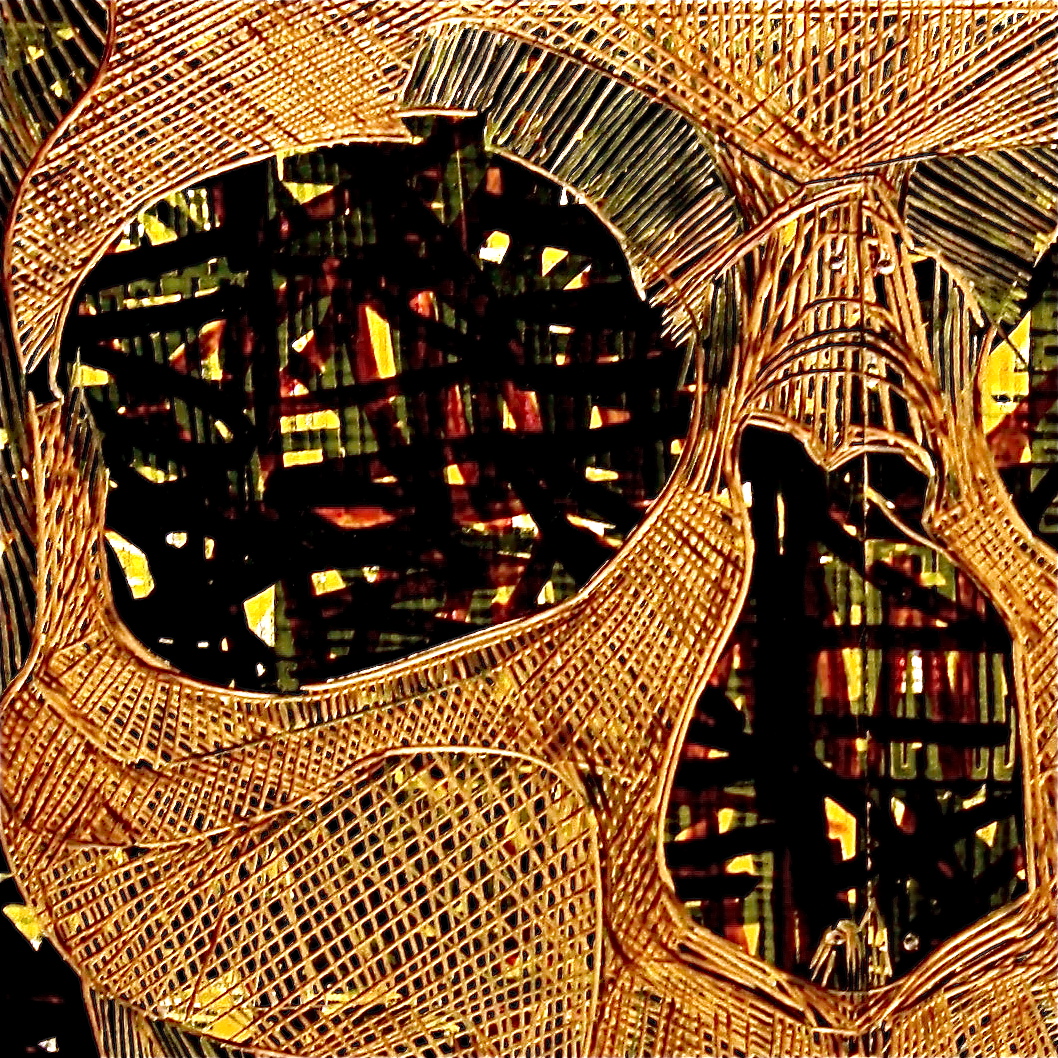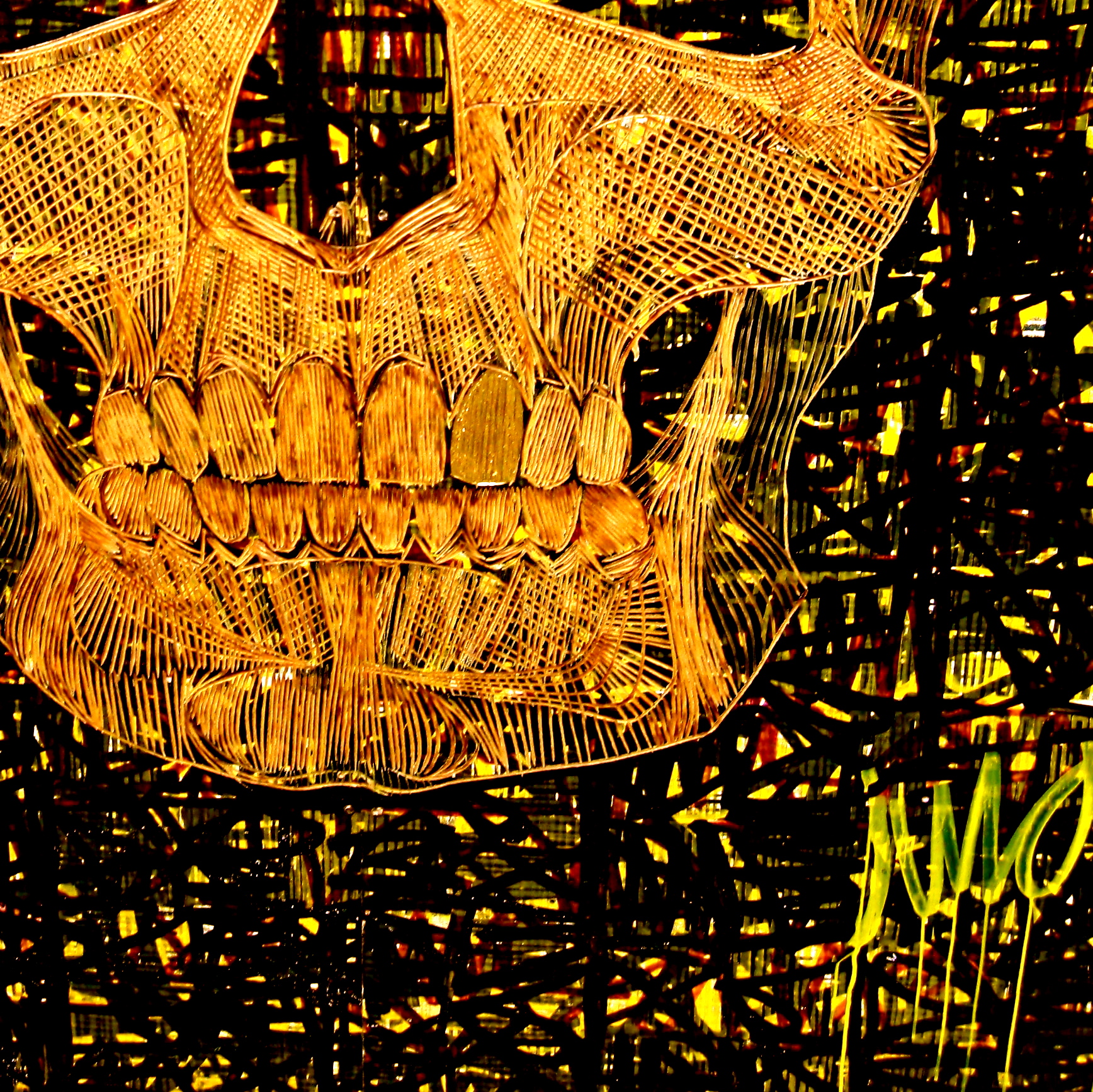
Many readers will probably have been puzzled by the words (shown right) permanently inked on a flagstone at the top of Broughton Street. They appear just below the steps leading up to the entrance of St Mary's Metropolitan Cathedral, and read:
LET THE DEAD BURY THEIR OWN DEAD. 1689
They have the kind of grim portentousness one expects of an Edgar Allan Poe story, or of a modern-day goth struggling to make sense of the 24-hour clock. Spurtle decided to investigate.
What soon became clear is that this is a Biblical quotation. In Matthew Chapter 8, Christ and the disciples are described preparing to cross the Sea of Galilee en route to the Gentile city of Gadara. One of the disciples (unnamed) tries to cry off, claiming that he cannot travel owing to a prior family commitment: the burial of his father.
This excuse prompts Christ's reply: 'Let the dead bury their own dead', the seemingly unsympathetic or impenetrable tone of which has led to it being described as one of his 'hard sayings'.
What does it mean?
Spurtle found three explanations more intelligible than the rest.
The first – and we paraphrase drastically – suggests that Christ was emphasising the need for spiritually engaged persons to dispose of the dead. This 'mainstream' interpretation is often criticised for its disconnection from any straightforward or commonsensical reading of the text.
A second explanation is that Christ was encouraging the hesitant disciple to prioritise active and vital ministry over comparatively unimportant funerary rites.
A third – advanced by Gordon Franz and based on the research of Byron McCane of Duke University – revolves around first-century AD Jewish burial practices.
Dem bones
We quote here from Franz:
After a body was placed in a burial cave, it was left to decompose. The family mourned for seven days. This initial mourning period was followed by a less intense 30-day period of mourning, called shloshim. However, the entire mourning period was not fully over until the flesh of the deceased had decomposed, usually about a year later. The Jerusalem Talmud states: When the flesh had wasted away, the bones were collected and placed in chests (ossuaries). On that day (the son) mourned, but the following day he was glad, because his forebears rested from judgment (Moed Qatan 1:5).
The final act of mourning, the gathering of the bones into a bone box called an ossuary, was called 'ossilegium,' or 'secondary burial.' It is this act, I believe, that is in view in our Lord's response. [For a good discussion of secondary burials, see Meyers 1971; Rahmani 1981. On ossuaries, see Rahmani 1982b]. The disciples' request and Jesus' response makes good sense in light of the Jewish custom of secondary burial. When the disciples requested time to bury their fathers they were actually asking for time to finish the rite of secondary burial. Their father had died, been placed in the family burial cave, and the sons had sat shiv'ah and most likely shloshim. They had requested anywhere from a few weeks to up to 11 months to finish the ritual of ossilegium before they returned to Jesus.
Jesus' sharp answer also fits well with secondary burial. The fathers had been buried in the family burial caves and their bodies were slowly decomposing. In the tombs, along with the fathers, were other family members who had died, some awaiting secondary burial, others already placed in ossuaries. When Jesus stated: 'Let the dead bury their own dead,' He was referring to two different kinds of dead in the tomb: the bones of the deceased which had already been neatly placed in ossuaries and the fathers who had yet to be reburied. The phrase 'own dead' indicates that the fathers were included among the dead.
Franz finally takes pity on the reader as follows:
An amplified (interpretive) rendering of this statement might be: Look, you have already honored your father by giving him a proper burial in the family sepulcher. Now, instead of waiting for the flesh to decompose, this can never atone for sin, go and preach the Kingdom of God and tell of the only true means of atonement, faith alone in Christ. Let the bones of you dead father's ancestors gather his bones and place them in an ossuary. You follow me!
1689 and all that
But wait, the message is about to become more explicit.
What, courteous Spurtle readers have been wondering, is the significance of the '1689'?
The likeliest explanation we've found is that it refers to the year in which Parliament passed the Act of Toleration, liberalising the state's response to religious organisations other than the established Churches of England and Scotland.
Soon after the legislation's passage, representatives of more than 100 Particular Baptist churches met to endorse a document. This London Baptist Confession of Faith cleared up various misapprehensions of 'heterodoxies and fundamental errors' wrongly charged to the signatories' part, laying down instead what they trusted would be an unmistakable declaration of their true beliefs.
Among these was the following:
26.4. The Lord Jesus Christ is the Head of the church, in whom, by the appointment of the Father, all power for the calling, institution, order or government of the church, is invested in a supreme and sovereign manner; neither can the Pope of Rome in any sense be head thereof, but is that antichrist, that man of sin, and son of perdition, that exalteth himself in the church against Christ.
Conclusion

Now, much as we enjoyed our brief researches on this subject, it has to be said that huddles of Broughton citizens do not routinely meet on street corners to discuss such finer points. Theological history has generally fallen out of fashion on Friday nights in the Barony; and even where it hasn't, few approach the subject from such an obscure angle.
Which leads us to wonder who on earth the theological graffiti-ist understands to be his or her target audience. Is there a street subculture out there we don't know about? Should we expect blast and counter-blast from the nozzle of a spraycan in future?
If you can throw any light on this subject, please do not hesitate to contact us by email spurtle@hotmail.co.uk on Facebook Broughton Spurtle or Twitter @theSpurtle